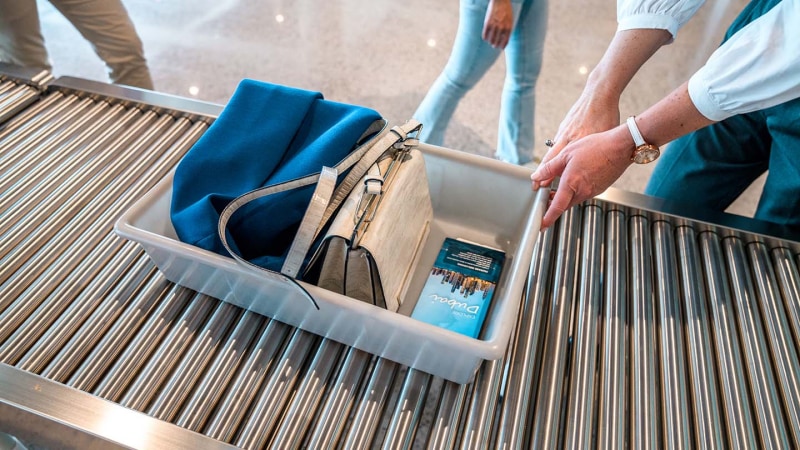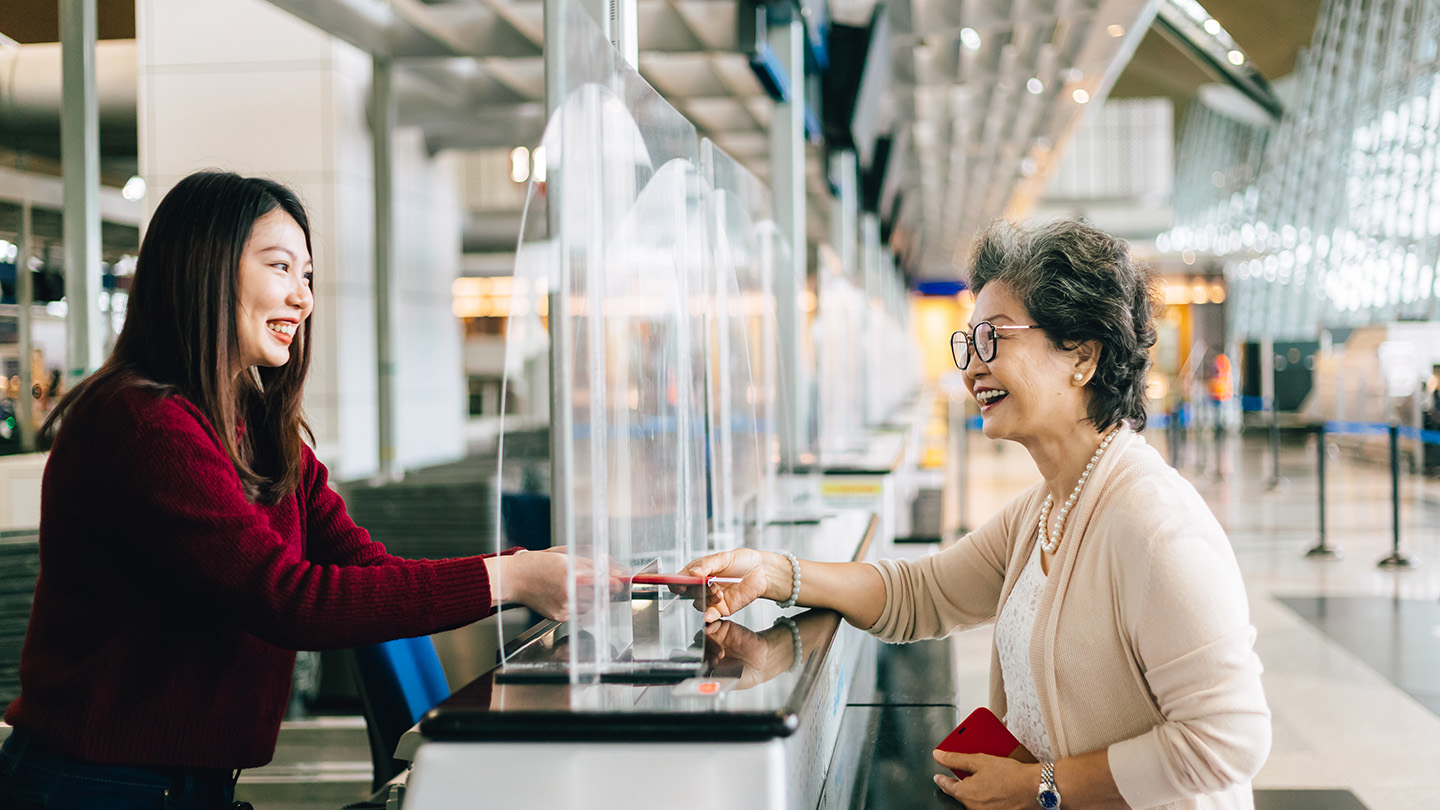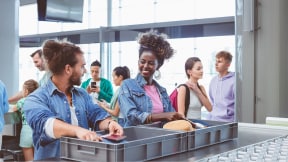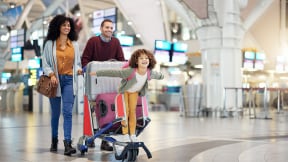Our guide to TSA rules

Quick insights
- TSA allows travelers to bring eligible liquids in their carry-on bag when they’re in 3.4-ounce containers and placed inside a single quart-sized bag.
- Many major airlines will allow you to bring a carry-on bag with dimensions of 22 inches x 9 inches x 14 inches or smaller.
- TSA PreCheck® members can often leave their shoes, belt and coat on during the security screening, and their personal electronics and liquids bag may remain in their carry-on bag.
On top of remembering what you need to pack for your trip, there’s also the matter of getting your bags through security screenings. The Transportation Security Administration (TSA) is the government agency responsible for implementing security measures at the airport. TSA sets many of the rules regarding carry-on and checked luggage, and knowing these rules may ease your travel experience.
Let’s take a look some things to know about TSA rules before your next security screening.
TSA rules
Knowing TSA rules regarding checked bags, carry-on bags and their contents may help you streamline the security process. Note that TSA provides the most up-to-date information regarding their security screenings.
Here are a few things to keep in mind.
Liquid and food rules
From medications to toiletries to snacks, you may be wondering what items you can pack in your carry-on bag. It may be helpful to know TSA carry-on restrictions. Below, you’ll find a few TSA rules regarding food, drinks and other liquids:
- 3-1-1 rule: 3-1-1 refers to 3 ounces, 1 bag per 1 person. This rule means that permitted liquids must be in containers that are 3.4 ounces or less in size, and TSA requires all of these containers to be placed inside a single, clear quart-sized bag. Drinks and creamy foods such as salad dressings, sauces and soups are also usually subject to this restriction.
- 3-1-1 rule exceptions: There are some exceptions to this rule, including medications, breast milk, baby food and formula. These items may be subject to additional screening but are generally permitted. You’ll usually need to inform the TSA officer if you have these items at the security checkpoint.
- Solid foods: In many instances, you can bring food through TSA. Solid foods, including sandwiches and chips, are generally permitted. In many cases, food items can remain in your carry-on during the screening process.
- Prohibited drinks and food: Creamy foods that may spill are typically not allowed if they violate the 3-1-1 rule. Additionally, alcoholic beverages over 140 proof are not permitted.
Banned items
Some items you cannot bring in a carry-on bag include weapons, ammunition, insecticides and sporting equipment that could be used as a bludgeon. Some restricted items may be permitted in a checked bag when travelers follow TSA’s instructions. TSA provides a full list of what you can bring.
TSA bag requirements
Baggage size requirements are generally set by each airline, not TSA. You can check your airline carrier’s website or app for current information regarding their size and weight limits for luggage, as well as any additional charges you may incur for bags.
Size requirements vary depending on the airline, but your luggage will likely meet the sizing criteria for several major airlines if bags fall within these dimensions:
- Carry-on bags: 22 inches x 9 inches x 14 inches
- Checked bags: 27 inches x 21 inches x 14 inches (no more than 62 inches total)
Note that TSA will inspect your carry-on bag via an X-ray machine during the security screening.
For checked bags, the screening usually occurs without the need for a TSA officer to physically search the bag. When your checked bag is physically inspected by a TSA officer, you’ll usually find a notice that this occurred inside of your bag.
If you want to place a lock on a checked bag, you may prefer to get one that’s TSA-approved, which means the brand has provided TSA with universal keys. However, it’s still possible the lock will be damaged during an inspection.
Other airport security check rules
You may be asked to remove any outerwear or bulky clothing, belts and shoes during a TSA screening. You may also need to remove certain items from your carry-on bag and place them in bins, including your liquids bag and any personal electronics larger than a cell phone.
TSA recommends keeping an organized carry-on bag to help ease the security screening process. An overstuffed, disorganized bag may make the process longer.
Rules for TSA PreCheck
TSA PreCheck is a membership program that allows travelers to access an expedited security line and screening process. TSA PreCheck screenings differ from standard screenings in several ways.
TSA PreCheck rules usually allow members to leave certain items on their person or in their carry-on bag during screenings, including:
- Coats
- Belts
- Shoes
- Liquids bag
- Personal electronics
However, members still need to follow their airline’s baggage size requirements and TSA’s 3-1-1 rule.
If you’re interested in getting TSA PreCheck, note that some credit cards offer reimbursement for the TSA PreCheck application fee.
In summary
Many foods and liquids are allowed in your carry-on bag, but for liquids, you must observe the 3-1-1 rule. This rule requires liquids to be in 3.4-ounce containers and placed within a quart-sized bag.
Airlines set the rules for luggage and carry-on bag size limits. A carry-on bag that’s 22 inches x 9 inches x 14 inches will likely comply with many major airlines’ sizing requirements. Several airlines allow checked bags that are 62 inches total or less.
Standard screenings often require travelers to take off any coats, belts or shoes and remove their personal electronics and liquids bag from their carry-on. If you have TSA PreCheck, you typically won’t need to remove these items during screenings.



